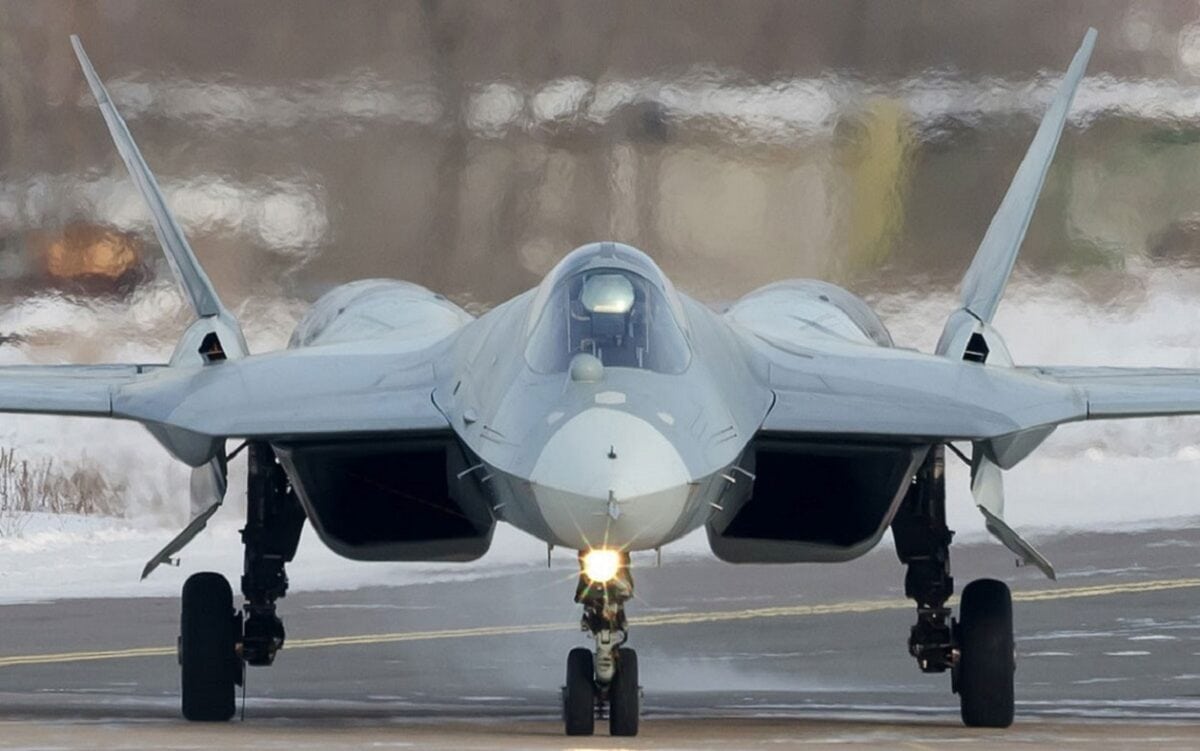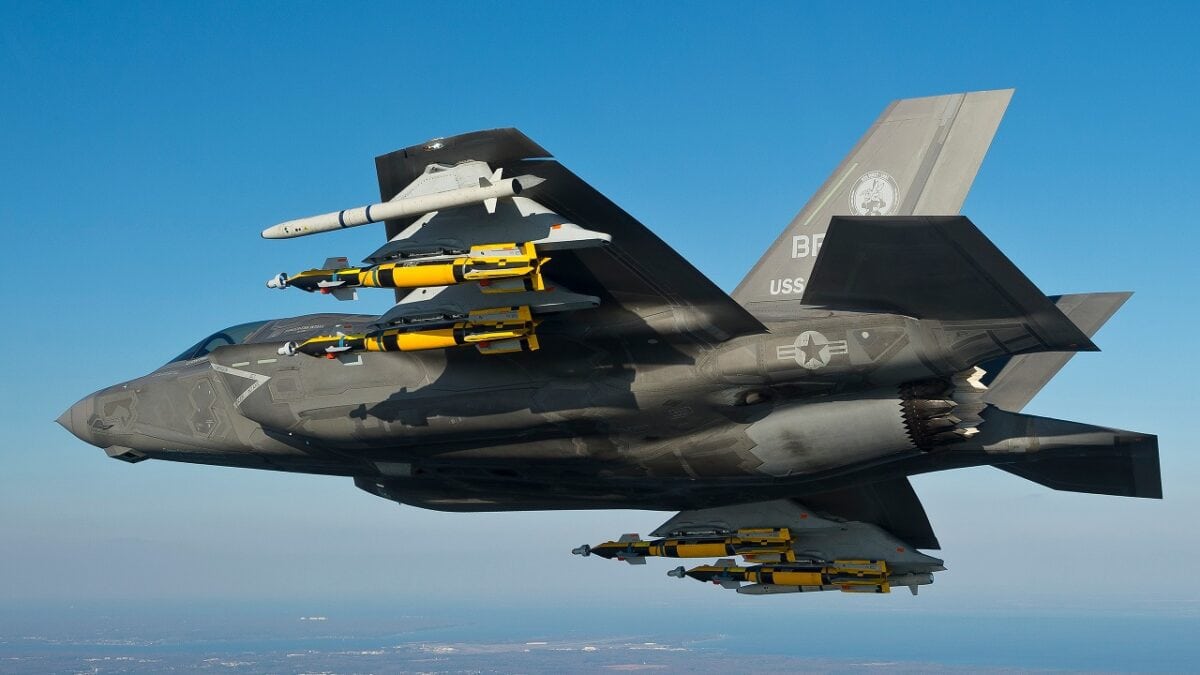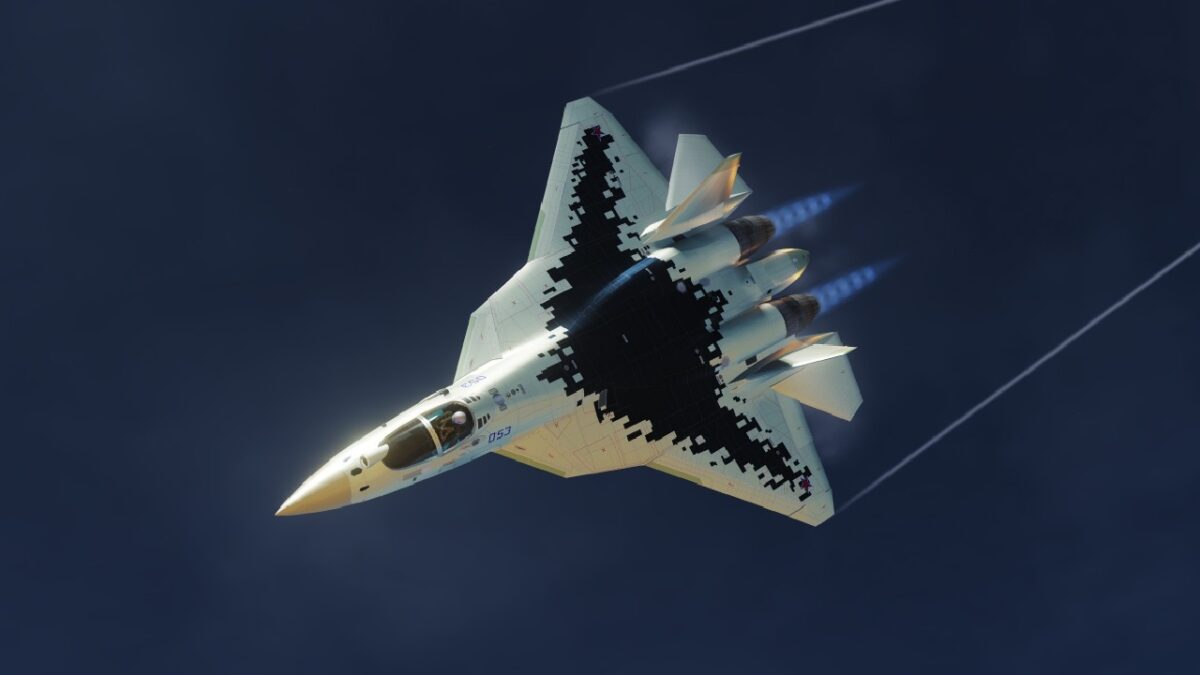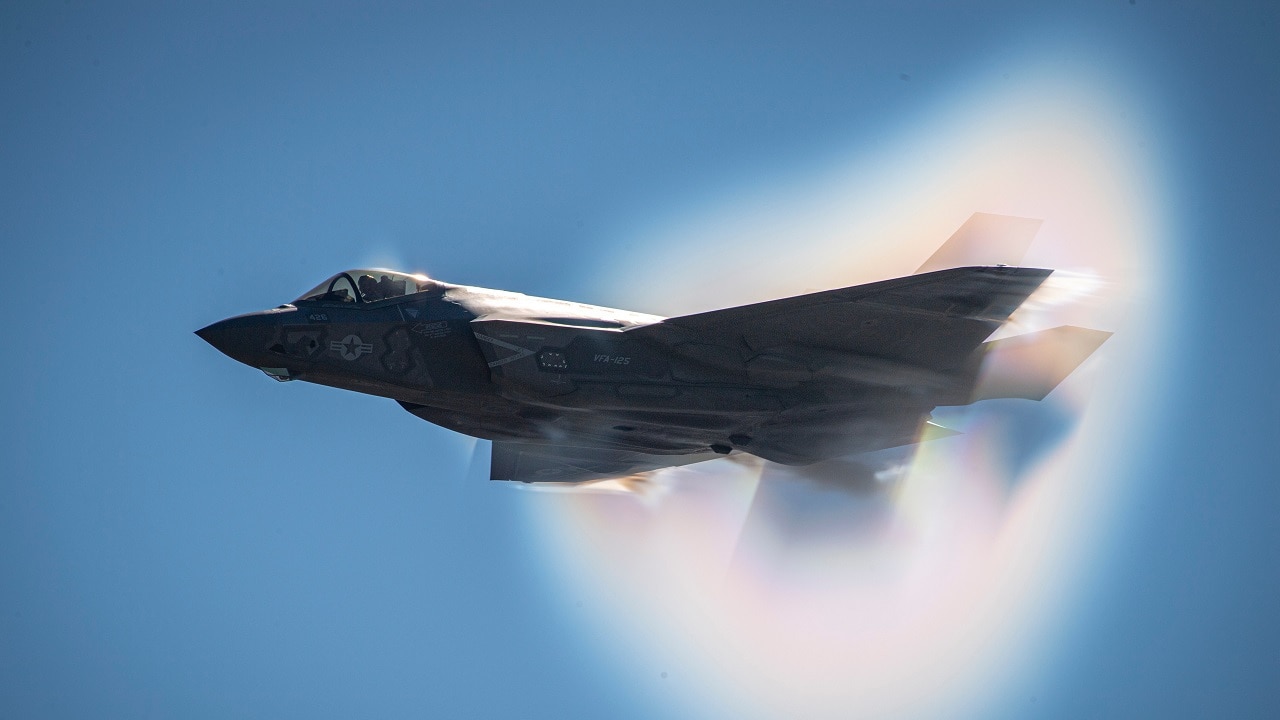Yes, there are constant comparisons of the F-35 and Su-57. But one key factor, how the planes are actually built, might be the most important and telling comparison of them all. It also means that Russia’s Su-57 Felon is in trouble.
In discussions about the world’s 5th generation fighters, Russia’s Su-57 often has a seat at the table right alongside American entries like the F-35 and F-22, as well as China’s J-20 and forthcoming J-31. But the fact of the matter is, these 1:1 fighter comparisons are good for driving clicks… but aren’t particularly valid in terms of comparing a nation’s actual combat capabilities.
This comparison of the Su-57 production line versus the F-35 production line really sums up the most important difference between these aircraft.
One is the most technologically advanced fighter in the world. The other is practically artisanal. pic.twitter.com/pGAYJauVUj— Alex Hollings (@AlexHollings52) October 1, 2022
The real truth is that production models of Russia’s Su-57 Felon are so rare that America has more aggressor F-35s playing the role of Russian stealth fighters for training than Russia actually has in service. When it comes to production, the F-35 simply beats the Su-57 before either aircraft can even be cleared for takeoff.
Su-57 vs. F-35
To date, Russian aircraft manufacturer United Aircraft Corporation (UAC) has delivered just six production Su-57s to the Russian Air Force. That figure would be seven, but the first ever production Su-57 promptly crashed shortly after take-off during its initial test flight.
Russia also has 12 prototype Su-57s, some of which have even been deployed operationally to places like Syria. However, these prototypes are so poorly finished that they almost certainly compromise the limited stealth capabilities the Su-57 is said to have under even the best of circumstances.
But a lack of capability can be compensated for through production volume… but unfortunately for Russia and its stealth ambitions, production is one of the Su-57’s biggest weaknesses.
While many articles may compare the F-35 and Su-57 in terms of single-aircraft specifications, you can find much more important insight in the above comparison of their respective production lines.
Despite not yet being approved for full-rate production, Lockheed Martin delivers between 130 and 156 F-35s per year, whereas UAC is optimistically aiming to deliver just 22 Su-57s by the end of 2024. Standing orders for the Su-57 sit at 76 — all from within Russia’s military despite the nation’s best efforts to court external buyers, whereas orders for the F-35 number in the thousands, with at least six new nations joining the waiting list in the past four years alone.
As of January 2022, Lockheed Martin had already delivered more than 750 F-35s to operators spanning 14 nations. In fact, when taking a tally of the largest operational stealth fighter fleets on the planet, the F-35 dominates the list, with 9 of the top 10 nations operating F-35s and Russia, with its Su-57 Felon, only reaching the 11th spot if you opt to include its problematic prototypes in its total count.
It’s no secret that F-35 production has had its issues over the years. In fact, despite reaching initial operating capability for the Marine Corps (the first U.S. branch to certify the jet for combat) more than seven years ago now, the fighter is still not projected to enter full-rate production until the summer of 2023 at the earliest.
These delays and cost overruns have led many to characterize the F-35 itself as a failure, but as we’ve discussed at length a number of times here on Sandboxx News, that’s an inappropriately simplistic view of what has admittedly become the most expensive defense program in history. Being expensive isn’t the same thing as being ineffective, and while the F-35’s acquisition process may have been a boondoggle, the aircraft itself has consistently proven to be among the most capable fighters ever to take to the sky.
Why the Su-57 Is a Stealth Fail
The Su-57 is said to have a radar cross-section (or radar return) that’s comparable to America’s 4th-generation F/A-18 Super Hornet flying without munitions or external fuel tanks — at least, when the Russian jet is properly finished with radar-absorbant materials over any visible gaps or seams. Without those absorbent materials, as shown in the image above, the fighter is likely much easier to spot.
According to Sukhoi’s own patent for the Su-57, it boasts a radar cross-section that’s somewhere between .1 and 1 square meters. That’s certainly a dramatic reduction compared to 4th-generation Russian fighters like the Su-27, said to be around 15 square meters, but is hardly comparable to the miniature returns produced by the F-22 and F-35. Common estimates place the F-35’s radar cross-section at around 0.0015 square meters and the even stealthier F-22 at between .0001 and .0002 square meters.
In other words, even the most optimistic Russian figures suggest the Su-57 is 1,000 times larger on radar than the F-22, with less optimistic numbers suggesting it may be as much as 5,000 times larger on the radar scope.
Building a Stealth Fighter Is Hard
But the Su-57’s lacking stealth isn’t necessarily a significant problem for the platform. After all, most fighters in the sky today lack stealthy designs or heavy use of radar-absorbing materials. Russia’s air warfare doctrine also doesn’t place nearly as heavy an emphasis on low-observability as the United States, making stealth a less essential part of warfare for Russian strategists.
Of course, like Russia’s failing doctrine of not attempting to secure air dominance seen in Ukraine, it would seem Russia’s lack of emphasis on stealth comes — at least in part — as a result of the nation’s struggle to field stealth technology en masse. Most people are already well aware that designing a stealth aircraft is a massive undertaking, but few realize that even with a phenomenal design, actually building stealth fighters in volume is a huge challenge in itself.

Su-57 Fighter. Image Credit: Creative Commons.
One of the biggest hurdles to mass-producing stealth fighters comes in the form of the extremely tight production or manufacturing tolerances required of stealth designs. Because even the smallest seam or gap in the body of a stealth aircraft can result in a larger radar return, a huge amount of effort goes into manufacturing panels to highly accurate specifications and then mounting them on the airframe with exacting precision. Any gaps are then covered in radar-absorbing material to prevent them from compromising the jet’s low observability.
What Sets the F-35 Apart
The F-22 Raptor, which was the world’s first stealth fighter and remains the stealthiest to date, was built using production tolerances of just 1/10,000 of an inch, but even its extreme precision and robot-assisted assembly are dated compared to the ongoing F-35 production process.
In fact, the F-35 is assembled with such tight tolerances (the figure is not disclosed) that the trade publication Modern Machine Shop reported in 2010 that its body panels don’t require any radar-absorbing epoxy where they meet, unlike like previous stealth aircraft like the F-22.
“And what permits the close matches? I saw the answer on a recent visit to Lockheed Martin’s manufacturing campus in Fort Worth, Texas. The answer, of course, is CNC machining. Composite skins are milled and drilled to such close tolerances that the plane’s assembled surface avoids the mismatches that radar can see,” Modern Machine Shope Editor in Chief Peter Zelinski wrote.
“In short, the precision obtained by this company’s CNC machining group has helped to realize a plane that is so effective, and so compelling in its capabilities, that other countries want to help us pay for it.”
F-35 Production is Years Ahead of the Su-57
Here in the United States, we tend to take things like manufacturing tolerances for granted — both because they’re not very exciting to discuss and because the easiest way to solve the tolerance problem happens to be America’s specialty: Just throwing a whole bunch of money at a challenge until it isn’t one anymore.
A great deal of the F-35’s development cost went into inventing the means to mass-produce such an exacting design. Lockheed Martin’s Flexible Overhead Gantry, lovingly referred to as the “FOG,” is a highly-sophisticated five-axis milling machine used to cut and drill the composite materials used in the fighter’s skin to such precise specifications that they fit together in an almost seamless way.

F-35 Joint Strike Fighter. Image Credit: Lockheed Martin.
The FOG can mill materials as large as 15 meters long and was described by the former technical operations deputy for F-35 global production, Dr. Don Kinard, as “the most accurate machine tool in the world for its size.”
The FOG system is so accurate that although it was built atop a specifically laid concrete foundation that’s a whopping 30 feet deep, it still carries ceramic gaging spheres in protective housings on each corner that monitor even the most minute shift in its footing on a daily basis. The cutting and milling tools leveraged by the FOG are held in special hydraulic holders that are individually balanced by measuring machines sourced from ultra-precision tooling firm Haimer.
The machine is so precise that its use led to the creation of an entirely new classification of machine technicians who are qualified to operate it at its Fort Worth facility. Techs who receive this specialized training are classified under “STEM,” short for Special Technology Equipped Machine.
Actual aircraft assembly has been increasingly automated over the years, now leveraging an integrated machine tool transfer line (MTTL) that allows for the production of as many as 20 forward fuselages per month, meaning full-rate production could pump out quite a few more F-35s than the 140 or so per year delivered thus far.
Su-57: The 1990s Wants Their Stealth Back
Russia’s manufacturing industries remain largely reliant on imported and dated European tools that simply don’t offer anything close to the same degree of precision, but that’s not all that’s holding them back. The production process for the Su-57 is hampered by a lack of funding in several important ways — starting with India backing out of the program in 2018, which reduced the developmental budget for the program by as much as $7 billion.
Some Twitter users pointed out that it may be unfair to compare the Su-57’s production to the F-35, suggesting that comparisons to early-build F-22s might be more appropriate. That argument, however, only emphasizes the overarching point here — that Su-57 production remains stuck in the late 1990s.

Su-57. Image Credit: Artist Created Image.
Russia’s Su-57s are built in Shop 45 of the Komsomolsk-on-Amur Aircraft Plant alongside commercial airliners like the Sukhoi Superjet 100. Unlike F-35 assembly, which uses the MTTL to literally move components from station to station along a lean-infused and highly automated production line, Su-57 production was only somewhat recently moved to Shop 45 in order to put as much of the assembly as possible in a single place.
“Before that, there were colossal losses of time,” said Artem Oshchepkov, the Shop No. 45 supervisor, in the factory’s internal publication.
In another stark contrast to the F-35’s heavily automated assembly process, Su-57s are largely assembled by hand.
“The new aircraft is complex,” deputy workshop head Viktor Passar said, citing “composite sheathing, the latest technologies, the highest quality requirements.”
“But we also have highly qualified personnel in our workshop,” Passar added.
Those highly qualified personnel that he’s referring to are paid an average of just $17,000 per year (as noted by the general director of UAC, Yuri Slyusar, in September). It is worth noting, however, that UAC has stated that they aim to pay their workers “at least 10% higher” than the mean income of the city they’re working in.
In August, UAC announced that it would be expanding its facilities to include a boathouse for testing radio equipment, a motor test station, and more production lines to support the standing Su-57 order — all to be funded by the Russian government. However, as we’ve seen with Su-57 orders themselves over the years, the Kremlin doesn’t often follow through with promises for funding for new defense programs, and global sanctions put into place following Russia’s invasion of Ukraine as well as equipment losses are sure to exacerbate budgetary issues within the Russian defense apparatus.
The Su-57 may eventually become a capable fighter platform that lives up to the legacy of past Russian and Soviet successes in the sky… but with limited funding and dated production facilities, it may never exist in sufficient numbers to prove it.

